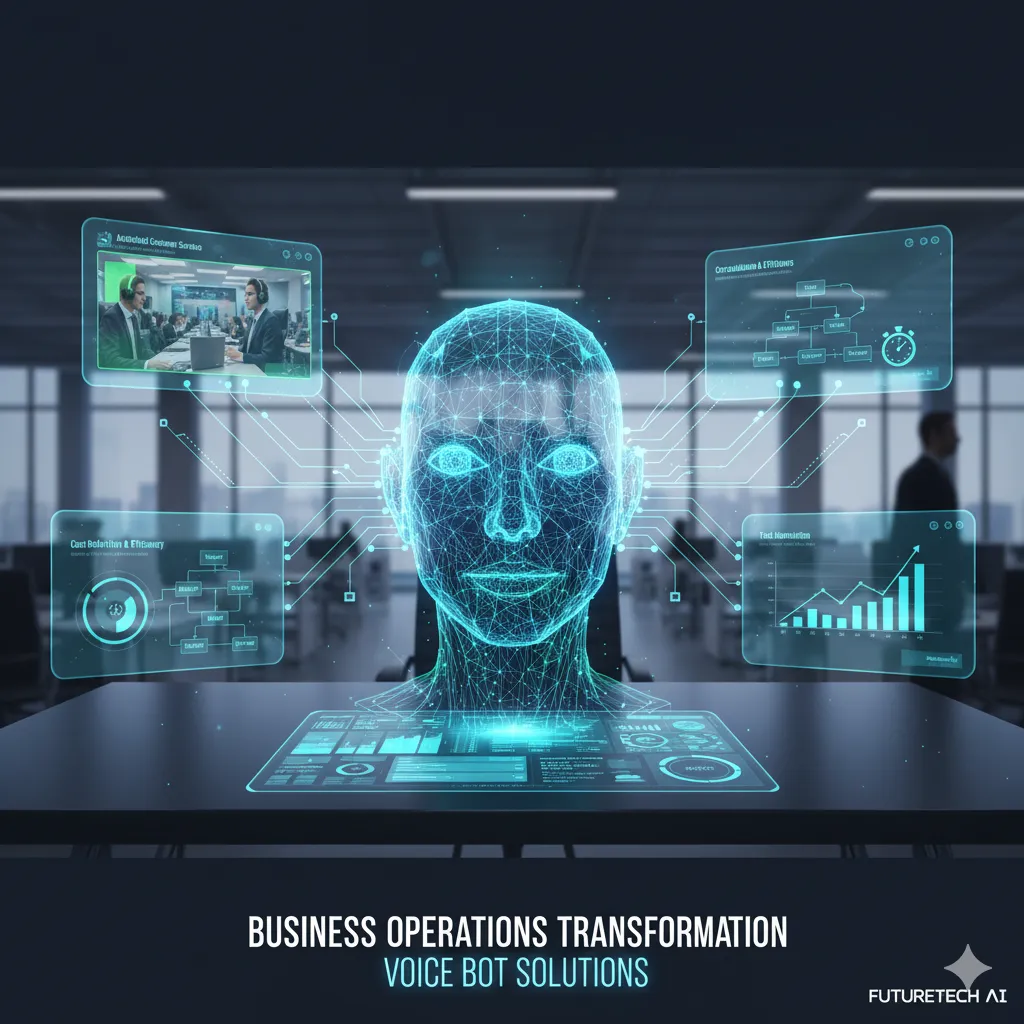
How can Business Operations Transformation be achieved using Voice Bot Solutions?

Voice AI automation uses speech recognition, natural language processing, and machine learning to understand spoken requests and complete tasks that used to need a human. These systems speed response times, cut down manual work, and turn conversations into structured customer data that powers smarter decisions and measurable efficiency gains. In this piece we walk through how voice AI works technically and operationally, unpack the core components that enable voice-driven automation, and examine workflows where conversational AI delivers clear ROI. You’ll see how AI-powered customer service and lead-qualification bots plug into CRMs, why responsible AI governance matters for trust, and how to measure results while moving from pilot to scale. We also profile The Power Labs' Four-Bot System- an example architecture made up of an AI Lead Generation Bot, AI Voice Bot, AI Chat Bot, and AI Smart Operations Bot that provides 24/7, context-aware automated engagement to improve both customer outcomes and operational efficiency.
What Is Voice AI Automation and How Does It Enhance Business Efficiency?
Voice AI automation combines Automatic Speech Recognition (ASR), Natural Language Understanding (NLU), and Natural Language Generation (NLG) to turn spoken language into structured actions, routing, or captured data that replace repetitive human tasks. By automating routine interactions: FAQs, appointment bookings, initial qualification, organizations cut average handling time and remain available around the clock. The outcome is lower cost per contact, faster responses that improve customer experience, and richer voice-derived data that fuels smarter workflows. Recent research also shows that when voice AI joins an omnichannel architecture, conversion rates improve because context and history travel with each interaction.
At a technical level, voice AI uses ASR to transcribe audio, NLU to detect intent and extract entities, and dialogue management to map those intents to actions, CRM updates, routing rules, or automated transactions. Together these pieces convert raw speech into structured fields, simplifying call transfers, populating lead records, and triggering downstream automation. Turning unstructured voice into actionable data removes manual entry and reduces errors, speeding service delivery. With this foundation, we can examine the concrete benefits for customer service and lead generation.
Operational gains from voice AI include 24/7 availability, dynamic routing, and the ability to handle peak demand without hiring proportionally more staff. Sales teams benefit too: continuous lead capture, automated qualification flows, and context-rich handoffs that improve conversion accuracy. Those advantages show up in key KPIs: lower cost per contact, faster time-to-lead, and higher CSAT.
How Does Voice AI Use Natural Language Processing to Automate Tasks?

NLP in voice AI is built from three core capabilities: ASR, NLU, and NLG. ASR turns audio into text; NLU detects intent and pulls out entities; NLG produces the spoken or written responses. That trio supports end-to-end voice workflows that automate routing, information lookups, and data capture. For example, a patient’s spoken request can be transcribed, classified as an appointment booking with date/time entities extracted, confirmed by an NLG-generated prompt, and then written into the scheduling system. These modular components standardize how voice data flows into backend systems, cutting manual entry and improving reliability downstream.
In live deployments, intent models are trained iteratively with domain-specific utterances and wired into orchestration rules that determine next steps; escalate to an agent, trigger a transaction, or schedule a follow-up. That automation reduces friction and produces predictable outcomes.
What Are the Key Benefits of Voice AI for Customer Service and Lead Generation?

Voice AI speeds answers, captures leads continuously, and personalizes interactions through context-aware dialogs. It cuts average handle time by automating routine questions, lifts lead capture rates by proactively engaging callers, and enriches CRM profiles with voice-derived attributes that make outreach more relevant. Those changes drive concrete KPI improvements: lower cost per contact, stronger conversion from initial engagement, and higher customer satisfaction thanks to faster resolutions. Voice-data also improves segmentation and enables more effective follow-ups, raising lifetime value and lowering churn risk.
Combining real-time transcription, intent scoring, and CRM enrichment creates a feedback loop for continuous optimization; delivering immediate automation wins and longer-term process improvements. That sets the stage for integrated multi-bot architectures that orchestrate voice, chat, and back-office automation.
How Does The Power Labs' Four-Bot AI System Unlock Operational Efficiency?
The Power Labs' Four-Bot System pairs four purpose-built bots: AI Lead Generation, AI Voice, AI Chat, and AI Smart Operations to deliver continuous, context-aware engagement across channels. The architecture routes leads from voice and chat into automated qualification flows, enriches records, and triggers operational tasks that replace manual work. The result is a holistic transformation designed to accelerate growth while enforcing responsible AI governance and 24/7 engagement. Below we map each bot’s features to business outcomes so teams can quickly see where value appears.
The following table compares each bot by core capabilities and expected outcomes to help teams scan the operational value of the Four-Bot System.
Bot: AI Voice Bot
Core capability: Speech recognition, intent handling, TTS personalization
Business outcome: Shorter wait times, improved CSAT, higher first-contact resolution
Core capability: Prospect outreach, lead scoring, enrichment
Business outcome: Faster lead capture, higher lead quality, improved conversion rates
Bot: AI Chat Bot
Core capability: Omnichannel messaging, context handoff, instant answers
Business outcome: Greater engagement, fewer chat-to-human transfers, consistent CX
Core capability: Back-office automation, task orchestration, data reconciliation
Business outcome: Faster onboarding, fewer manual errors, reduced operational load
This shows how each bot contributes to operational gains and how shared context between bots amplifies value.
What Are the Features and Benefits of the AI Voice Bot for Customer Engagement?
The AI Voice Bot focuses on accurate speech recognition, intent-driven routing, and brand-aligned responses to handle routine interactions without human intervention. Key features include ASR tuned to industry vocabulary, intent classifiers that trigger transactions or escalations, and personalized TTS that reinforces brand tone while confirming actions like appointments or orders. These capabilities reduce wait and handle times, increase first-contact resolution, and feed more qualified leads into sales pipelines. Track KPIs such as containment rate, time-to-qualification, and voice-derived enrichment accuracy to measure both efficiency and revenue impact.
Successful deployment requires training on domain terms and reliable integrations for CRM updates and escalation paths.
How Do the AI Lead Generation, Chat, and Smart Operations Bots Complement Voice AI?
The AI Lead Generation Bot runs outreach, qualification scripts, and enrichment before handing prospects to sales; the AI Chat Bot maintains conversational context across web and messaging channels; and the AI Smart Operations Bot automates back-office tasks like reconciliation and onboarding. Together, these bots form handoffs where the Voice Bot captures intent, Lead Gen scores and enriches, Chat follows up omnichannel, and Smart Ops completes administrative steps shrinking the path from lead capture to revenue. Example workflows include a voice lead that’s scored, receives chat follow-up with a tailored offer, and triggers Smart Ops to create an account and schedule fulfillment. These cross-bot flows cut manual touches and shorten sales cycles.
This orchestration preserves continuity: when a human takes over, they get a pre-populated context that speeds resolution and improves conversion. That naturally leads to voice-driven lead generation and sales automation.
How Can AI Voice Bots Improve Lead Generation and Sales Automation?
Voice bots strengthen lead generation by capturing conversational signals early, scoring intent in real time, and enriching CRM records with voice-derived attributes that improve routing and prioritization. Automating qualification and enrichment reduces time-to-lead and increases the throughput of sales-ready prospects without proportional headcount growth. Connected to CRM and sales automation tools, voice bots enable immediate handoffs into nurture sequences or SDR outreach, accelerating conversion velocity.
Voice-driven capture uses scripted dialogs and intent detection to classify leads: cold, warm, or sales-ready and attach structured fields like need, timeline, and budget to CRM records. Those attributes feed automated nurture rules or immediate outreach, shortening cycle time and raising qualified appointments.
Conversion gains come from targeted qualification scripts, richer context for sales conversations, and automated follow-ups triggered by voice events. Voice signals: intonation, urgency, explicit intent add nuance to scoring models beyond forms alone, producing higher-quality leads and better sales outcomes. Below are practical ways voice AI helps sales.
Real-time qualification: Conversational flows assess readiness and set priority.
CRM enrichment: Voice-extracted entities populate profiles for personalized outreach.
Automated handoffs: Qualified leads trigger workflows or calendar bookings instantly.
Continuous nurturing: Call outcomes feed multichannel nurture sequences automatically.
These capabilities yield measurable improvements in conversion metrics and lower cost per qualified lead.
What Role Does AI Lead Generation Bot Play in Automating Sales Funnels?
The AI Lead Generation Bot is the funnel’s front door: it initiates outreach, identifies intent, scores prospects, and enriches records with context that speeds handoffs to sales. It automates initial touchpoints, calls and screening questions so human reps can focus on high-value conversations while the bot manages scale and consistency. Typical funnel stages include voice capture, automated qualification, enrichment from external sources, and routing to nurture or immediate sales contact. This approach shortens response time, raises qualification accuracy, and increases the number of sales-ready opportunities.
Automating early funnel stages and feeding structured, scored leads into CRM workflows lets teams scale prospecting without sacrificing conversion quality. That leads into how voice-based qualification drives better outcomes.
How Does Voice AI Qualify Leads and Increase Conversion Rates?
Voice AI qualifies leads using intent detection, context-aware dialog flows, and dynamic scoring rules that blend voice signals with CRM history to produce an accuracy-weighted readiness score. Qualification scripts ask focused questions- budget, timeline, decision-maker and the bot captures answers as structured entities that update lead scores. Voice-derived cues such as response speed or affirmative language can augment traditional scoring, boosting predictive accuracy. These refinements reduce false positives and help sales prioritize higher-probability leads, which improves close rates and shortens sales cycles.
Better scoring plus immediate automated handoffs create a smoother buyer experience and more efficient conversion economics.
What Are the Industry-Specific Applications of Voice AI Automation Tools?
Voice AI delivers high-impact value in healthcare, retail, and banking by addressing operational pain points like scheduling, order status, and transaction support. In healthcare, voice bots automate appointment booking, triage, and reminders while respecting privacy and compliance. Retail uses include order tracking, return processing, and personalized promotions that cut support calls and recover lost sales. Banking applies voice AI for balance checks, fraud alerts, and transaction routing with secure authentication. Across sectors, voice AI solves scale problems, reduces repetitive work, and captures missed opportunities through consistent 24/7 interactions and accurate data capture.
The following subsection offers concise examples for each industry and highlights compliance considerations where relevant, followed by a cross-industry look at the operational challenges voice AI addresses.
Use cases include clinical scheduling and reminders in healthcare, dynamic order status and returns handling in retail, and secure transaction support plus fraud detection in banking. Regulated sectors require consent flows, data minimization, and encryption to meet compliance standards. Retail implementations focus on seamless omnichannel continuity so voice interactions carry into web and mobile without losing context. These examples show how voice AI produces tangible operational improvements and set up the cross-industry mapping that follows.
Common operational challenges solved across industries include eliminating repetitive manual tasks, capturing after-hours leads, and ensuring consistent responses that reduce errors. Voice bots handle high-volume transactions, preserve conversational context for human handoffs, and generate structured data for analytics and continuous improvement. That cross-industry impact explains why organizations prioritize conversational AI for efficiency and why responsible AI practices are essential for trust.
How Is Voice AI Used in Healthcare, Retail, and Banking for Efficiency?
In healthcare, voice AI automates appointment scheduling, triage, and reminders while integrating consented patient data into scheduling systems to cut no-shows and administrative load. Retail uses include order-status checks, return handling, and personalized offers that reduce support demand and boost repeat purchases. Banking leverages voice AI for balance inquiries, fraud alerts, and routine transaction routing with secure authentication to ease customer access and lower branch visits. Each sector needs tailored integrations and compliance controls, but all implementations deliver measurable reductions in handling time and better service continuity.
These sector examples highlight the need for industry-tuned intent models and governance controls, which leads into the next subsection mapping operational challenges to bot capabilities.
What Operational Challenges Does Voice AI Solve Across Different Industries?
Voice AI tackles high-volume repetitive work, missed after-hours opportunities, and inconsistent customer experiences by offering consistent automated responses and structured data capture for downstream processing. Bots manage transactional workloads and escalate to humans when complexity rises, freeing people to focus on higher-value tasks while reducing error rates. Measurable impacts include lower average handling time, fewer manual data-entry mistakes, and increased capture of out-of-hours leads together improving throughput and customer satisfaction. The following section turns to how responsible AI practices build trust in these automated interactions.
AI Voice Agents: Enhancing Operational Efficiency in SMEs AI platforms and voice providers can help organizations achieve meaningful operational efficiency. This research examines cost–benefit tradeoffs for gender-responsive AI voice agents in small and medium-sized business operations and shows how these tools can optimize processes. Optimizing Cost-Benefit Efficiency of Gender-Responsive AI Voice Agents for Enhanced Small and Medium Sized Business Operations, 2025
How Does Responsible AI Implementation Enhance Trust in Voice AI Automation?
Responsible AI for voice means designing systems with transparency, fairness, and security so customers know how their data is used and receive consistent, nondiscriminatory treatment. Practical governance steps: consent flows, data minimization, explainable dialog logs, and human-in-the-loop escalation increase adoption and reduce regulatory and reputational risk. The business benefits include higher customer trust, smoother regulatory alignment, and lower operational risk foundations for scaling voice automation sustainably.
Putting responsible AI into operational controls, consent capture at call start, anonymized analytics, and audit trails for dialog decisions helps voice automation respect privacy while remaining explainable. Those controls boost customer confidence and create defensible processes for regulators, which makes audiences more receptive to automated engagement.
What Are The Power Labs' Responsible AI Principles and Their Business Impact?
The Power Labs centers Responsible AI on transparency, fairness, and security. Transparency makes it clear when customers interact with AI and how decisions are made; fairness reduces bias in intent models and scoring; security protects voice-derived data in transit and at rest. Business outcomes from these principles include stronger customer trust, easier regulatory alignment, and a lower risk of biased outcomes that could damage reputation. These principles matter for pilots and scale because they address the enterprise concerns that block adoption.
Embedding these principles into operations is essential for long-term success; the next subsection explains specific technical and governance practices to put them into action.
How Does Responsible AI Ensure Transparent and Secure Customer Interactions?
Responsible voice AI requires concrete controls: consent prompts at session start, data minimization and retention policies, explainability logs for dialog decisions, encryption of audio and transcripts, and role-based access to sensitive data. Human-in-the-loop checkpoints for high-risk actions and periodic bias audits of intent models further ensure fairness and accountability. Together, these controls create traceability and explainability that reassure customers and regulators. Governance boards and continuous monitoring round out the operational picture and prepare organizations to measure ROI from secure, transparent voice automation.
These measures protect customers and increase stakeholder confidence, enabling broader rollout and clearer measurement of business impact.
Risks and Responsible Deployment of AI Voice Bots in Business This research highlights potential risks and threats posed by AI voice bots while also outlining their benefits. It stresses the need for responsible deployment of voice bot technology in customer service and business operations to ensure security and ethical use. Analyzing and mitigating the threats & risks of AI voice bots, A Dhaliwal, 2024
How Can Businesses Measure ROI and Get Started With Voice AI Automation Tools?
Measuring ROI for voice AI combines baseline benchmarking, controlled pilots, and ongoing measurement across KPIs like cost per contact, average handle time, conversion lift, and CSAT. Start with discovery to define baselines, run a pilot that tests targeted use cases with control groups, then phase integration and scale with analytics and governance checkpoints. Before outlining implementation steps, note that tight analytics integration and governance checks are essential to validate early wins and manage bias or errors.
What Metrics Demonstrate the Efficiency Gains From AI Voice Bots?
Key metrics to track include average handle time, containment rate (interactions resolved without human transfer), cost per contact, lead-to-opportunity conversion, and customer satisfaction. Measurement uses baseline collection, control-group A/B tests, and CRM/analytics instrumentation to attribute outcomes to automation. Benchmarks vary by industry, but common targets are 20–35% reductions in handle time and double-digit improvements in qualified lead conversion. Continuous monitoring and iterative model retraining keep improvements durable.
Tracking these metrics requires integrated dashboards and alignment across product, operations, and analytics so measurement is reliable and optimization is continuous.
AI Voice Bots for Business: Automating Sales and Customer Service Organizations are integrating AI-powered voice bots into sales and support to automate data entry, lead qualification, and follow-ups—improving efficiency and customer engagement. As voice assistants and related interactions evolve, they enable more natural and effective communication. AI-Driven Sales Automation: Enhancing Lead Generation and Customer Engagement, 2025
What Are the Steps to Implement The Power Labs' AI Automation Solutions?
To deploy a Four-Bot approach, follow a phased roadmap: (1) Discovery: define high-value use cases, map workflows, and collect baselines; (2) Pilot: run focused voice or lead-gen flows with control groups and clear KPIs; (3) Integration: connect bots to CRM, channels, and back-office systems with secure data practices; (4) Scale: expand bots and channels while monitoring governance and performance; (5) Govern & Optimize: enforce Responsible AI controls, retrain models, and iterate dialog flows. Responsibilities span business owners, IT, and analytics, and pilots typically run 4–12 weeks to validate early results. These steps create a repeatable path from proof-of-concept to enterprise automation.
Discovery: Map processes and capture baselines to build the ROI case.
Pilot: Run controlled tests with clear KPIs and success criteria.
Integration: Connect bots to CRM and analytics while enforcing security controls.
Scale & Govern: Expand use cases, maintain Responsible AI checkpoints, and optimize continuously.
These steps offer a prescriptive path to adoption while preserving the measurement discipline needed to prove value.
Frequently Asked Questions
How to use AI to improve efficiency?
Voice AI unlocks efficiency by automating repetitive tasks, enabling faster information capture and processing, and enhancing both customer service and internal team productivity. This is achieved through capabilities like natural language processing (NLP), real-time data analysis, and seamless system integrations.
What types of businesses can benefit from voice AI automation?
Voice AI helps a wide range of industries—healthcare, retail, banking, and customer support among them. Healthcare benefits from automated scheduling and triage; retailers reduce support volume and improve order experiences; banks use voice for balance checks, fraud alerts, and secure routing. Any business with repetitive voice interactions or missed after-hours opportunities can see operational gains and better customer outcomes.
How does voice AI ensure data security and compliance?
Voice AI platforms protect sensitive data with end-to-end measures: encrypted audio and transcripts, consent prompts, strict retention policies, and role-based access. Regulated industries add controls like data minimization, audit trails, and periodic compliance reviews. Those safeguards both protect customers and make automated systems easier to certify under industry rules.
What are the common challenges businesses face when implementing voice AI?
Common challenges include integrating voice AI with legacy systems, ensuring transcription and intent accuracy for domain-specific language, and managing internal change as roles shift. Technical work often centers on CRM connections and orchestration rules. Clear change management, phased pilots, and focused training data for your domain mitigate these risks.
How can businesses measure the success of their voice AI initiatives?
Measure success with KPIs like average handle time, containment rate, conversion rates, and CSAT. Establish baselines before deployment, run controlled pilots, and use CRM and analytics instrumentation to attribute outcomes. Regularly review and iterate on models and dialogs to sustain and improve results.
What role does user feedback play in optimizing voice AI systems?
User feedback is essential. Surveys, monitored calls, and direct feedback loops help identify misclassified intents, awkward dialogs, and UX gaps. Use that input to retrain models, refine scripts, and improve response accuracy. Continuous iteration based on real users keeps the system effective and trusted.
Can voice AI be integrated with other technologies?
Yes; voice AI integrates with CRMs, chatbots, analytics platforms, and back-office systems. These integrations let voice interactions enrich profiles, trigger workflows, and create a unified engagement ecosystem that improves personalization and operational efficiency.
What future trends can we expect in voice AI automation?
Expect more context-aware NLP, deeper personalization, and tighter integration with IoT and augmented reality. Voice systems will grow more adaptive to individual preferences and deliver richer signals for scoring and routing. As these capabilities mature, businesses will find new ways to use voice AI to streamline operations and elevate customer experiences.
Conclusion
Voice AI automation transforms how teams handle routine interactions, streamlining service, capturing better leads, and automating manual work so people can focus on higher-value tasks. When paired with responsible AI practices and a measured pilot-to-scale approach, these tools deliver clear operational and customer benefits. Explore a pilot tailored to your needs to see how voice AI can improve efficiency and outcomes for your business.